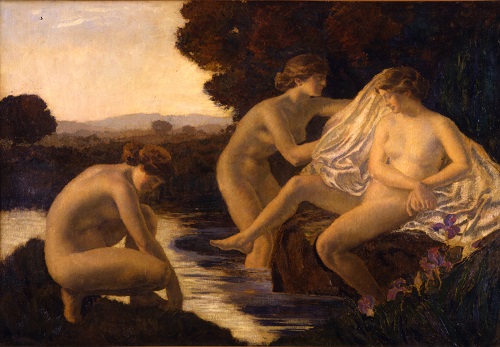Emile-René Ménard (French, 1862–1930)
The Bath of Diana, ca. 1920
Oil on canvas, 33 ½ x 48 ½ in.
Signed lower left: E. R. Ménard
DM38

Ménard attempted to convey the characteristics of the Golden Age of Greek civilization through muted, quietly contemplative Symbolist landscapes. After studying in the ateliers of the notable academicians William-Adolphe Bouguereau and Paul-Jacques-Aimé Baudry, he entered the Académie Julian in 1880 and began his career with biblical and mythological subjects. Over time, he began creating more generic visions of an idyllic Arcadia, representing statuesque male and female nudes in serene landscapes–reminiscent of the works of Nicolas Poussin, Claude Lorrain, and his older contemporary Puvis de Chavannes. Ménard, however, does not merely mimic the idealism of the French classical tradition, but incorporates plein-air sketches and figure studies drawn from life. As a youth, Ménard spent time among the artists of the Barbizon School, which likely had an impact on his work.
The Bath of Diana reflects Ménard’s interest in ancient sources through its subject matter—a mythological episode long favored by artists. Without the title, however, Ménard’s subject is not readily identifiable—absent is the goddess’s insignia of bow and quiver, leaving only a nude female figure attended by a companion and a third woman kneeling at the water’s edge. Ménard created at least two versions of The Bath of Diana in 1920. The other, exhibited at the Paris Salon of 1921, portrayed a more expansive scene than the version in the Dahesh collection—with five bathing female figures and two deer. In 1921, La Revue de l’Art Ancien et Moderne complimented Ménard’s integration of natural truth and mythological fiction, asserting that such a combination demonstrates the malleability of nature and landscape painting. Ménard’s oeuvre exemplifies how the classical vocabulary continued to inspire artists well into the twentieth century, and how such works form a bridge from Neoclassicim to the Symbolist movement. In 1900, he was nominated as an Officer of the Legion of Honor, and in 1910 he became a member of The Institute. Toward the end of his career, Ménard replaced his customary muted hues with a more vibrant palette.


